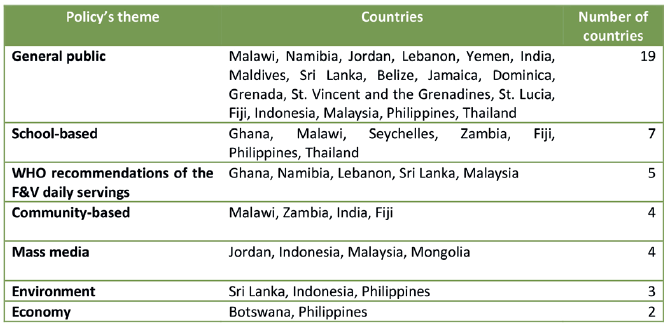Policies to increase fruit and vegetable consumption and physical activity in 49 low- and middle- income countries
According to the World Health Organization (WHO), noncommunicable diseases (NCDs) have become the leading cause of death worldwide, with ~80% occurring in low- and middle-income countries (LMICs)1. Today, there is broad consensus on the healthpromoting effects of regularly consuming fruit and vegetables (F&V), as evidenced by numerous scientific studies: eating F&V daily helps combat NCDs like heart disease, cancer, diabetes, obesity and many other chronic diseases.
2.7 million lives could be potentially saved if we sufficiently increase F&V consumption2! Due to the benefits of F&V consumption on health, the joint FAO/WHO committee recommended in 2002 a minimum daily intake of 400g of F&V and made it an ultimate goal for all countries in 20043.
Furthermore, the prevalence of physical inactivity- considered as a major risk factor for NCDs by the WHO- is also increasing among LMICs4. The WHO recommends that children and youth (5-17 years old) practice at least 60 minutes of moderate- to vigorous-intensity physical activity (PA) daily, and adults at least 150 minutes of moderate-intensity aerobic PA per week5. Given that these behaviours are important modifiable risk factors for NCDs prevention, the WHO encourages the development of policies to increase F&V consumption and PA, mostly in LMICs.
We reviewed policies to increase F&V consumption and PA in 49 LMICs* between 2004 and 2013.
Of the 49 countries, 57% had policies** to increase F&V consumption and 76% had policies** to promote PA. 51% had policies to increase both.
Policies to increase F&V consumption
28 countries out of 49 had policies to increase F&V consumption and 21% of them had adopted their policy. We have grouped the countries based on their policy’s theme (Table 1):

Table 1: Country specific policies to increase F&V consumption presented by World Bank regions and grouped based on themes
* The LMICs included in the study were Benin, Botswana, Ghana, Malawi, Mauritania, Namibia, Senegal, Seychelles, Sudan, Swaziland, Tanzania, Zambia, Algeria, Djibouti, Egypt, Jordan, Lebanon, Libya, Morocco, Syria, Tunisia, Yemen, India, Maldives, Pakistan, Sri Lanka, Argentina, Belize, Bolivia, Costa Rica, Dominica, Grenada, Guatemala, Guyana, Honduras, Jamaica, Peru, St. Lucia, St. Vincent and the Grenadines, Suriname, The former Yugoslav republic of Macedonia, Fiji, Indonesia, Malaysia, Mongolia, Myanmar, Philippines, Thailand and Tonga.
** In the article, a policy could also be an action plan or a guideline.
For example, Malawi has a school-based policy to establish school gardens and cooking demonstrations in all public primary schools. It also has a community-based policy to conduct community level demonstrations on the preparation and consumption of nutritious foods such as F&V, and a guideline targeting the general public to eat a fruit after every meal. In Namibia, one of the guidelines for the general public is to eat a variety of F&V, preferably fresh and locally available indigenous varieties. As an example of policies targeting the environment, Indonesia encourages food farming to ensure accessibility and availability of food balanced nutrition including F&V. Furthermore, we have noted that the Philippines has developed a policy targeting the economy by encouraging the provision of subsidies/tax breaks on healthy foods such as F&V so as to increase consumption. Among the five countries that developed strategies to meet the WHO recommendations, Ghana, Sri Lanka and Malaysia urge eating at least 5 servings of F&V daily while Lebanon recommends consuming 2 servings of fruit and 2-3 servings of vegetables daily.
Given the limited number of countries that have policies targeting the environment and economy, LMICs should formulate more strategies targeting these areas. If F&V are not available nor affordable, education alone will be inadequate to increase F&V consumption, and is supported by recommendations by Miller et al.6
Policies to promote PA
There were more policies formulated to increase PA compared to F&V consumption. Thirty-seven countries out of 49 had policies to promote PA, and 5% had adopted their PA policy. Most of the strategies are targeting the general public and only 9 countries out of the 37 formulated policies to meet the WHO daily PA recommendations.
In addition, 8 countries developed school-based policies to promote PA. Among them, Ghana, Maldives, Dominica, Grenada and Guyana recommend mandatory physical education in schools.
However, despite the progress made, LMICs are still lagging behind in developing policies to meet the WHO recommendations aimed at increasing F&V consumption and PA.
Based on: Darfour-Oduro SA, Andrade JE, Grigsby-Toussaint DS; Review of policies to increase fruit and vegetable consumption and physical activity in 49 low- and
middle-income countries, Journal of Public Health, https://doi.org/10.1093/pubmed/fdy039
References
1. World Health Organization. Global Status Report on Noncommunicable
Diseases 2010. 2011
2. Joint FAO/WHO. Workshop on Fruit and Vegetables for Health; Vol.39. Kobe:
Japan, 2005.
3. Joint WHO / FAO Expert Consultation. Diet, nutrition and the prevention of
chronic diseases. WHO Technical Report Series. 2003
4. World Health Organization. Global Health Risks Mortality and Burden of
Disease Attributable to Selected Major Risks. Geneva. 2009
5. World Health Organization. Global Recommendations on Physical Activity for
Health. 2010
6. Miller V, Yusuf S, Chow CK et al. Availability, affordability, and consumption
of fruit and vegetables in 18 countries across income levels: findings from the
Prospective Urban Rural Epidemiology (PURE) study. Lancet Glob Health 2016;
4:695–703.
